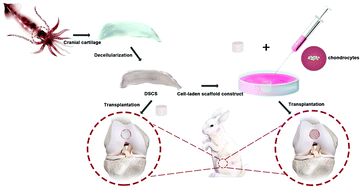A decellularized scaffold derived from squid cranial cartilage for use in cartilage tissue engineering†
Abstract
Decellularized cartilage scaffold (DCS) is an emerging substitute for cartilage defect application. However, it is hard to preserve an intact structure of such scaffolds derived from terrestrial animals, because of their dense and compact constitution. In contrast, squid (Dosidicus gigas) cranial cartilage, which possesses a relatively loose structure, could be easily decellularized using mild conditions and it retains the original microstructures of extracellular matrix (ECM). Herein, decellularized squid cranial cartilage scaffold (DSCS) was fabricated successfully after substantially removing the cells, which contained abundant ECM components (proteoglycans and type II collagen). Microscopic structure results showed that the DSCS possesses a relatively smooth and dense surface with a favorable interconnected inner porous structure for cell growth. DSCS exhibited excellent biomechanics and hydrophilicity. In vitro experiments indicated that the scaffold extracts were not toxic to cells, and were amenable to chondrocyte migration. Meanwhile, chondrocytes seeded in DSCS could maintain a favorable viability and present a spreading morphology. Furthermore, the in vivo experiments revealed that both cell-free scaffold and cell-laden scaffold exert promotive effects for the regeneration of cartilage in a full-thickness rabbit cartilage defect model. Taken together, these results suggested that DSCS presents a novel and promising cell-free therapeutic choice for cartilage tissue engineering.



 Please wait while we load your content...
Please wait while we load your content...